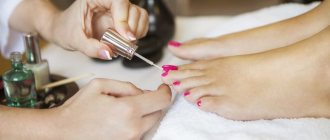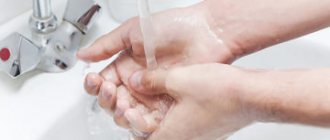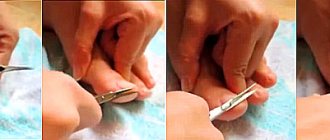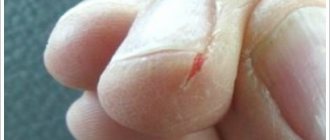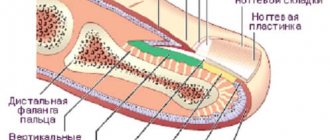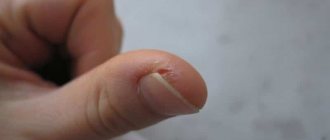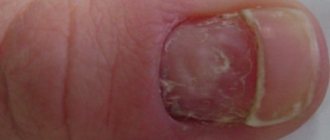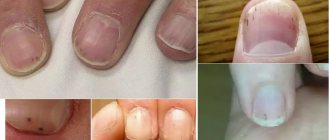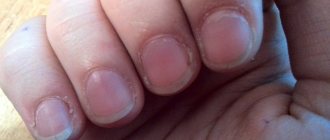Home page » Beauty » Nails
Author of the article
Svetlana Pavlikhina
Reading time: 6 minutes
AA
In everyday life, people encounter various household injuries. Insignificant at first glance, they can cause irreparable harm to health. Frequent injuries include bruises and compression of the limbs. As soon as a person pinches a nail with a door or a heavy object, it is necessary to urgently save the horny plate, otherwise it may fall off.
First aid
In the first minutes after receiving an injury, you need to remember what to do and how to cope with the damage yourself. The right decision would be to urgently seek medical help.
If this is not possible, perform the following actions:
- Apply ice to the damaged nail.
- If a bruise forms under the stratum corneum and pain increases, pierce the nail with a hot needle treated with medical alcohol. As a result of this, blood comes out through the hole, swelling and pain decrease.
- Treat the nail plate and the area under it with iodine or any other antiseptic.
Such manipulations help preserve the nail and neutralize the consequences of damage.
How to relieve pain
In the first minutes after injury, dry cold (ideally ice in a heating pad, in a bag) is applied to the damaged area. This reduces the intensity of pain and relieves swelling.
When the pain from dull, aching develops into throbbing, and the nail turns blue, take painkillers (Ibuprofen, Nurofen, any analgesic).
Tablets are taken according to instructions.
If there is no relief within half an hour, the finger is swollen, contact a traumatologist.
Bruised nail plate, how to remove the damage?
In this case, it is necessary to release the blood from under the nail to relieve pain and stop festering. The best solution in this case is to contact a traumatologist. A specialist will do this in a short time. After this, the nail will not have to be removed, it will not peel off or hurt.
The main advantage of contacting a specialist is safety. After all, if you try to carry out such an operation yourself, you can get an infection. Further consequences will only worsen the condition of the nail and increase the pain.
Color change
Depending on the condition of the wound after the accident, further actions are determined. The color of the nail can tell you about the depth of the injury.
Blackening of the nail
Blackness under the nail is formed due to hemorrhage under the stratum corneum. The blood turns dark after clotting.
If the finger is not damaged (there is no fracture) and the nail does not peel off, then pain and swelling are relieved by applying cold. You cannot keep this compress for more than 15 minutes.
When the nail plate is damaged or there is a break, a liquid antiseptic is poured into the wound and a clean bandage is applied over it.
Blood under the nail
Such damage appears after a severe bruise or pinched finger. When the pain intensifies, you need to see a traumatologist. At home, the nail is pierced with a heated needle to release blood and reduce pain.
If the blood is clotted (curdled), the nail turns black, the clot is removed with manganese baths.
Several crystals of potassium permanganate are dissolved in warm water, and hands are immersed in the solution for 15 minutes. This disinfects the wound and removes the resulting bruise.
Blue in the face
A bruise under the nail forms after a slight injury. The consequences can be easily eliminated by applying cold to the sore finger for 15 minutes. Then remove the ice for 20 minutes and reapply it.
Every day, the damaged area is lubricated with Heparin ointment. The product helps relieve swelling and eliminate bruising.
It is worth noting
To avoid infection of the injured area, even if there is no blackness under the nail, it is necessary to treat the nail plate itself and the skin of the finger with an alcohol solution of iodine, peroxide, and any other antiseptic.
After providing first aid, you need to go to the emergency room and tell the doctor that your finger is pinched and the nail has turned black. The doctor will decide what to do depending on the complexity of the injury. Perhaps a visual examination is not enough and it is necessary to take an x-ray to make sure that the phalanges of the finger in a bruised toenail or hand are not broken.
How to prevent peeling
If the blow was powerful, the stratum corneum will come off partially or completely.
To prevent the nail from falling off, the damaged area is washed with hydrogen peroxide and Bepanten ointment is applied.
For prevention, antifungal agents are used twice a day. A pressure bandage or medical plaster is applied to the site of the impact.
If the nail still peels off
If several days have passed after the injury, the hematoma on the hand has subsided, but the nail has begun to peel off, it is cut off. Afterwards the finger is treated with Chlorhexidine.
The procedure is repeated as the nail grows, until the stratum corneum is completely renewed. This way the nail comes off without causing discomfort to the owner.
Damage to the nail plate
With severe bruises, the nail breaks and cracks.
Such damage can be caused, for example, by a car door or a heavy object.
What to do
First of all, cold should be applied to the injury site to prevent the formation of a hematoma.
Then the wound is disinfected with any antiseptic. You can apply an iodine grid to your finger. This way, swelling will not appear not only under the stratum corneum, but also on the finger.
The nail is wrapped with adhesive tape to prevent it from being rejected.
Treatment
To save the damaged area from peeling, the formation of edema and hematoma should be prevented. To do this, a small hole is made in the nail. The procedure must be performed by a doctor .
In special cases, an adult can do this independently:
- The nail and the skin around it are treated with alcohol, iodine, and brilliant green.
- A sewing needle, pin, or hairpin is heated well over a fire.
- A puncture is made in the middle of the nail to the skin under the stratum corneum.
- As soon as the needle reaches the skin, it is removed, pressed on the finger, releasing blood through the hole.
Afterwards, the finger is thoroughly treated with an antiseptic, a bandage is applied, and secured with a pharmaceutical adhesive plaster. They do this procedure on their own only in emergency cases, if it is not possible to get to a doctor.
Nail damage in children
In children, such injuries occur quite often. For primary symptoms of damage, it is necessary to treat the wound and apply cold.
If the swelling increases and the skin under the nail turns blue, you should seek medical help.
Often the child cannot tolerate the increasing pain. It is necessary to give Panadol or children's Nurofen before the doctor arrives. This way the baby will not suffer from severe pain.
Therapy
In pediatrics, the treatment of such injuries differs little from adult traumatology. If the nail plate can be protected from delamination, swelling is relieved and the wound is disinfected.
When the integrity of the nail cannot be maintained, it is removed and a sterile bandage is applied. It is changed periodically until a healthy nail grows.
How does a nail bruise occur? What are its consequences?
Injury to the nail plate usually occurs in everyday life. Most often they suffer:
- Big toe. It can be hurt by tripping over a threshold, hitting a hard object, such as the leg of a sofa, or dropping something heavy on your finger.
- Index finger on hand. It is nailed with a hammer, pinched by a door, etc.
IMPORTANT: Nail bruises often occur in children when they fall onto a hard surface, for example, from a bicycle or scooter. As a rule, such an injury frightens children and causes them suffering.
Symptoms of a bruised nail plate are:
- Hematoma. When struck with a blunt object, the capillaries under the nail plate burst. Blood collects under the skin or just under the nail. In the first case, the nail turns blue, in the second it turns black. In this case, the victim may feel a swelling in the fingertip
- Pain. The victim may feel a burning or throbbing pain under the nail plate or throughout the finger. Sometimes the pain goes away within a few minutes after the injury, sometimes it remains for a long time. It happens that if the injury to the nail plate is severe, even touching the finger and simple manipulations with the hand give the victim discomfort. This is the symptom that ultimately forces a person to seek medical help.
- Swelling of the finger. It may become swollen, and the skin of the last phalanx turns red for a while
IMPORTANT: Sometimes the pain from a bruised nail is so severe that the victim loses consciousness.
Most often, bruises occur on the big toe.
After a bruise, blood circulation in the finger under the nail will be disrupted. The blood accumulated under the plate puts pressure on it. Often the damaged nail is raised and torn off. This happens over several days or weeks. In the best case, by the time the damaged nail comes off, a new one will already grow under it.
Treatment options
To preserve the damaged layer, remove swelling, get rid of pain, and cure the finger, various methods are used.
Traditional
After receiving an injury, first aid is provided on the spot: cold is applied to the site of the injury, the wound is treated with an antiseptic. If the damaged area hurts, take any available analgesic. Local anesthetics are used.
To relieve swelling and inflammation, heparin gel is applied to the bruise and the adjacent area twice a day, and a sterile bandage is applied.
Traditional methods
To relieve swelling and pain, use pharmaceutical bodyaga. These are dried and crushed sea or freshwater sponges. The product is used as a local anesthetic and anti-inflammatory agent.
The powder is diluted with water to the consistency of thick sour cream, applied to the injury, and kept for 15–20 minutes.
The procedure is repeated several times a day.
As soon as the swelling subsides, hand baths made from chamomile and lemon balm are used. Dry herbs (1 tbsp) are poured with a glass of boiling water and left for half an hour.
The healing infusion is cooled to room temperature, and the bruised finger is dipped into it for about half an hour.
Folk recipes
If a girl pinches her finger in a car door, how can she relieve the pain at home? You can use time-tested, effective folk remedies to treat a bruise.
More details about these recipes are given below:
- pick the plantain and wash it. Mash the plantain leaf thoroughly until you obtain a paste, and most importantly, juice. Apply plantain juice to the sore spot. If there is no plantain nearby, you can apply a cabbage leaf or a cut half of aloe as a compress. After 3 hours, change the compress. If you pinch your finger, the swelling and pain will quickly go away, but if the limb is fractured, this recipe will most likely be useless.
- Wrap the mashed potatoes in a gauze napkin and apply it to your finger until the mixture has cooled completely. Such procedures must be performed every 2 hours.
- generously lubricate the painful finger with fresh sour cream, keep it in this state for 10-15 minutes. Such pleasant procedures should be repeated until the pain subsides and swelling decreases.
- make the following compress: pour 1 glass of boiling water, 1 teaspoon of birch buds and 2 teaspoons of horsetail, leave the composition to brew. Then soak a gauze pad in this infusion and apply it to the painful area, securing it with a bandage. Apply such compresses twice a day until the unpleasant symptoms completely go away.
Consequences
If an adult or child pinches a finger, and after the injury there is no way to treat and treat it, inflammation, infection develops, and necrosis of the skin under the horny plate occurs.
This can lead to the loss of a nail or even a finger..
With severe bruises, the nail will peel off; the wound underneath must be protected from any infection. To do this, the finger is disinfected several times a day and a sterile bandage is applied.
If the damaged layer is not removed, this leads to the growth of a new deformed nail. It will be thin, weak, crooked. On the hands it does not look aesthetically pleasing; on the toes such a defect makes it difficult to wear shoes and affects the gait.
Fracture or bruise?
Only a doctor can say exactly what the result of pinching is after taking an x-ray. But any person also needs to know how to identify injury and bruise based on certain signs.
In any case, there will be severe pain. Moreover, this does not depend on whether a finger on the hand was injured or the person hit the door frame with his toes. Any such injury causes a painful shock.
When the first bright and very unpleasant sensations pass, the person realizes what happened. A picturesque bruise appears on the finger and swelling may increase. This occurs due to an increase in local pressure. A bruise is the result of damaged blood vessels on the finger.
First of all, you need to understand what type of lesion is present, this can be done by the following signs:
- You can move your finger, if you can do this, even despite severe pain, there is most likely no fracture.
- If, despite any attempts, the finger still does not move, and attempts to bend it cause unbearable pain, then most likely a fracture has occurred.
You need to handle a fracture with extreme caution so as not to aggravate the situation. To do this, the injured finger must be immobilized. This can be done at home by putting a splint on it. After this, immediately go to the doctor.
The importance of medical assistance in case of a fracture of even a finger is very important, because the bones may heal incorrectly, and this will lead to a decrease in the mobility of the phalanx, and a visual deformation may form.
Seeing a doctor
Home treatment is ineffective and can lead to more serious consequences than losing a nail.
Qualified medical care is necessary in the following cases:
- suspected fracture of a finger;
- delamination, fracture of the nail;
- unbearable, throbbing pain;
- formation of extensive edema;
- a diabetic patient or child was injured;
- when there is a suspicion of tissue sepsis (necrosis);
- if a limb is severely pinched, a foreign object has gotten under the horny plate, which cannot be removed independently.
Duration of the recovery process
After receiving a strong blow, in 90% of cases the damaged, deformed nail plate peels off.
The injured stratum corneum disappears in 1 month, and a new one grows in about six months.
To speed up the process, the damaged surface is removed. When the bruise is minor, the pain goes away after 2-3 days .
The swelling subsides after 1-2 weeks, the skin under the nail will recover.
On the legs, the healing process is slower. During this period, you should avoid tight shoes.
Regular therapy is required for complete restoration of the nail plate.
